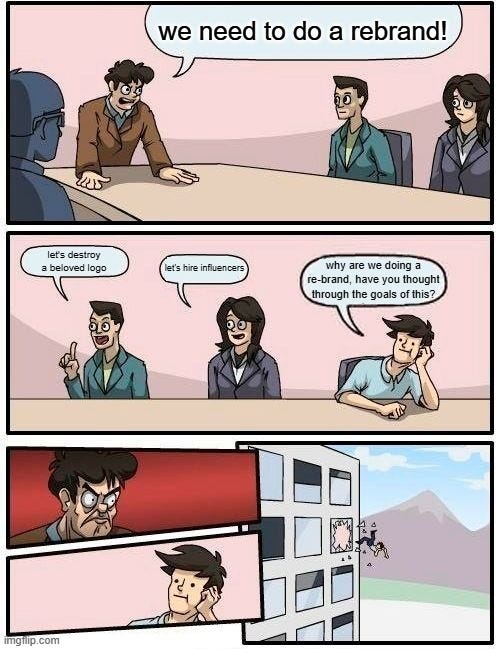What's really going on in marketing
People hate that the professional managerial class is neutering everything into a soulless blandscape

I guess we have to write about marketing again. I don’t talk about this subject here much these days because it’s fairly easy to get right. Well, it is if you pay attention to things, which for a lot of people is asking way too much. It’s actually a great time for marketers by the way, as we continue to see national conversations about brands in the zeitgeist, as just saw with the Sydney Sweeney ad (which I wrote about here in case you missed it).
Anyway, my friend Isaac Simpson did a fantastic breakdown of the latest brand logo fiasco on Substack here or on YouTube here. I highly suggest watching it, it’s very good and I’d agree with most of it. Ignore all the “woke” commentary because as Isaac points out that’s kind of a distraction from what’s really happening (remember ‘woke’ or anything else is only done in corporate America in so far as people think they have to for a promotion).
I want to talk about this a bit more too, because people do care about marketing. They love it when it’s done well. They hate it when it’s done poorly. But what they don’t do is ignore it. The idea that marketing is irrelevant or could be replaced by AI is something people who badly misunderstand the world think, or perhaps they’ve never had actual professionals on their team ship real creative, and have just worked with lifeless managerial class bureaucrats. None of these people understand “risk” is part of the job, or really how to calculate it. And anyway, the riskiest thing right now for a consumer brand is to ship the blanded idea or logo that looks like an evil villain took over the company.
A lot of people think the backlash is political, but that’s not what’s happening here. It’s visceral. People are sick of being presented with lifeless, flattened brands that look like they were the result of 10 meetings with McKinsey. For a while, everything was moving in that direction: logos stripped down, colors muted, design simplified to the point of anonymity. There were practical reasons for this such as app icons had to be legible at tiny scales and signage had to be clear. Apple did the simplicity thing first and best. But not every company is Apple. And when everyone follows that formula, you end up with a landscape of brands that look like soulless clones, each one indistinguishable from the next. Not everything should look like a tech company or be ruined visually simply because smartphones exist.
This is more self-destruction than being anything close to marketing. And since the marketing sector is mostly rudderless and leaderless there’s very few willing to raise their hand and push back against any of this. In fact, my experience is you get professionally punished for saying the right thing or even just asking questions in the room at many large companies. Something like this is about right for what happens.

Maybe this is why I’m at a startup, I just couldn’t handle the politics and careerism at large companies (this is another actual risk for most brands, by the way). Maybe if corporate America gains back their sanity I’d consider it again.
Anyway, what people hate is the sense that the professional-managerial class has sucked all the humanity out of a company. That every decision has been made by a committee obsessed with avoiding offense, checking boxes, and general culture of safetyism. The result is work that feels condescending, pious, and bloodless. It doesn’t connect, it doesn’t inspire, and it certainly doesn’t sell. It’s everything normal people have grown to despise. And yet marketers continue to do it.
Compare that with what great marketing once was. Coke’s “I’d Like to Buy the World a Coke” wasn’t safe, it was audaciously sentimental. Nike’s “Just Do It” didn’t emerge from a DEI workshop, it came from a real, raw cultural current about pushing limits. Volkswagen’s legendary Beetle ads didn’t look like anyone else’s, they looked like themselves, and they were funny, charming, and human. These weren’t campaigns designed to appease managers. They were designed to delight people.
Somewhere along the way, we lost that nerve. We let branding become about looking respectable to other corporations instead of creating an emotional spark in actual human beings. We let design become about “not missing the mark” (sigh) instead of actually making any kind of mark or impression. Everything is soulless and empty, and that’s why so much of it fails.
The one thing I do like about this drama is it lets us kill the lazy refrain that “no one cares about marketing.” People care deeply. They just won’t tolerate being treated like a captive audience for PMC-approved, paint-by-numbers slop. They want to feel something: delight, pride, humor, beauty, ambition. They want brands with the courage to stand out, not melt into the gray slurry of corporate sameness.
The opportunity is right here if you’re paying attention. All it takes is rejecting the bad ideas management consultants (who aren’t even really marketers) told you were a ‘best practice’ and remembering what marketing is supposed to do: move people. Stop letting bureaucrats destroy your company and let creatives build it once again.



The kind of manager to reach for the kind of rebrand covered here, rarely appreciates what firms need to keep what they already have and even less to get more and keep it. They are in a hurry.
The quickest way is to cut costs. Such measures include cutting customer-service, firing non-flashy employees, instituting measures that make running the firm convenient for employees and not for customers, adding product features management likes and charge customers for those bright ideas. Think of MS software. The push is 'Change something, to boost eps'. Making cost and financial changes is the easiest thing in the world--any dope can do it and for a while look like a hero.
Might as well sell off assets and liquidate, then where would the CEO work? Oh! How about getting rid of nearly everything, but keep a PO Box open and ask the public to send regular checks there? Ideal, if you can make it work. IF!
Firms exist to satisfy customers with a good or service that customers both need and want. Many firms must also compete with other firms for customers to satisfy.
Firms have to make a profit, but profit is a residual--what's left after costs. Profit is a requirement of survival not the purpose of survival. Think like this. Do you breathe to live or breathe to live? Firms are not in business to make a profit, nor in business to make losses either. Too many losses spell doom.
The dirt-floor truth is without customers firms cannot exist. Satisfying and keeping a customer is easier and cheaper than getting a disappointed customer back. Start losing customers and the end could be near.
Contrary to Harvard Business School, my old school, the order of priorities is not: Stockholders, management, employees, then customers.
The order of priorities is customers, employees, managers, then stockholders. Stockholders of firms that follow those priorities end up with plenty. Unless a firm has a near-monopoly, firms that ignore those priorities stagnate then die.
I bet the CEO and CMO of Cracker Barrel have MBAs as most companies require for roles like this. That’s why everything is being reduced to the same strategies and tactics—it’s all essentially the same archetypes. It’s all the same playbook. maybe hiring “proven” leaders is actually riskier than it used to be these days.